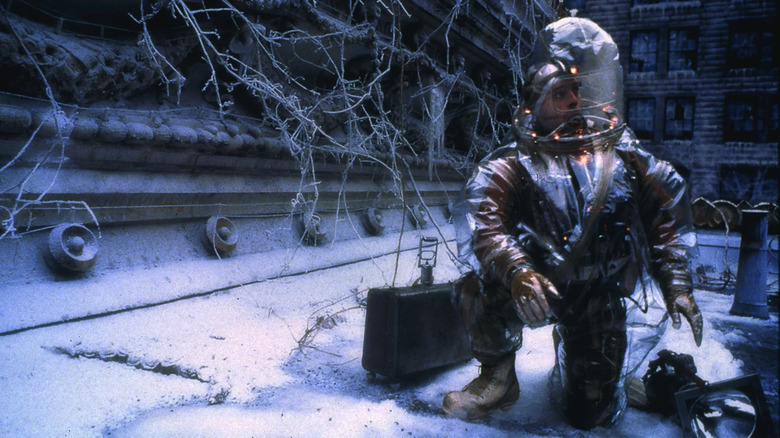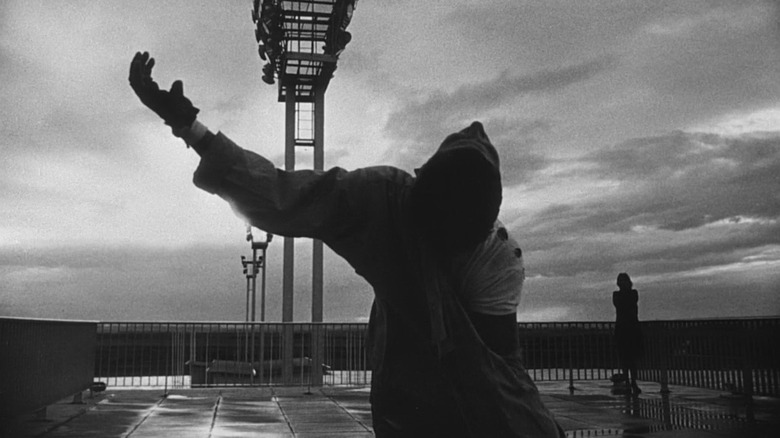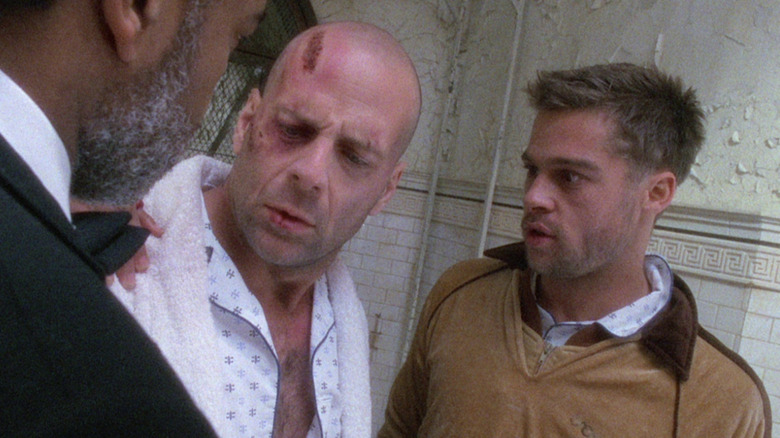How 12 Monkeys Put A New Spin On Time Travel Movies
By the mid-'90s any script for a film that featured time travel had the burden of inevitably being compared to two heavy-weights of the genre. First there was "Terminator" (1984) which not only twisted the trope of the post-apocalyptic wasteland into one dominated by merciless A.I., but famously sent its hero into the past to alter the future. A year later and audiences received a less dire and more lighthearted vision of time travel with the first installment of the "Back to the Future" trilogy. By 1995 movie-goers had seen another hero go into the past, this time Arnold Schwarzenegger, to protect humanity's savior John Connor in "Terminator 2: Judgement Day."
All this is to say when "12 Monkeys" premiered in 1996 there was a sense that time travel was becoming overplayed, and audiences might unfairly compare it to similar, critically loved examples of the genre. Luckily the film was both a critical and commercial hit thanks in no small amount to its inspired script from screenwriting couple David and Janet Peoples. Today such a film about a man sent back in time to decipher the origins of a global plague, battling his own sanity and incongruence to the era, would feel depressingly prescient. But when it was first released "12 Monkeys" presented something revolutionary and novel to the time travel genre. Though the film owes a great debt to another, lesser-known piece of cinema for being such a successful, atypical standout.
The French New Wave short that inspired 12 Monkeys
According to a comprehensive history of "12 Monkeys" published at "The Ringer," it all started with executive producer and apparent cinephile Robert Kosberg. It was he who persuaded director Chris Marker to let him pitch to Universal a full-length remake of his sci-fi film "La Jetée" (1962). When Universal agreed, assigning the Peoples to pen the screenplay, it was producer Charles Roven who brought director Terry Gilliam onboard. Famously many of the central players made it a point to reveal they'd never seen "La Jetée" prior to creating "12 Monkeys." Roven never saw it, nor did the Peoples: "It was one of those very famous pictures that you think you should have seen, just like you should have read Proust, but we hadn't." While Gillian for his part "vowed not to until he was done with his own movie," though his reasoning was he'd seen enough of the stills from the film to "get the gist."
It's important to note that Marker's "La Jetée" is a 28-minuted short comprised nearly only of still images. In this film no one saw before making their own, a story is told in black and white images of humanity driven underground by nuclear fallout and of an imprisoned man sent back in time by scientists of the future to gather the information that could "rebuild a postwar existence." But for Peoples to write and Gillian to direct another time travel movie about escaping a nuclear wasteland would've been to risk comparison to the "Terminator" series. "Terminator one and Terminator 2 are in our minds masterpieces. There isn't a way we want to look like we were copying those pictures," David explained. So just how did Peoples alter the screenplay of this initial "remake" of a French new wave film in a way that separated it from other time travel films?
12 Monkeys mixed current events into sci-fi bits
One of the glaring differences between "12 Monkeys" and other examples of time travel in cinema is how much guinea pig time traveler James Cole's (Bruce Willis) sanity is questioned throughout. Not just by himself or other characters – but also by the audience themselves. Dave told "The Ringer" that he and Janet realized making the central protagonist an unreliable narrator opened a refreshing new dimension in the plot.
"We're in Berkeley, so it would not be particularly unusual if somebody came up to you and told you that he was a prisoner who escaped from the future."
"12 Monkeys" might be heavily inspired by "La Jetée" but it's due to Peoples personal embellishments that the film stands-out decades after its release. Ironically enough, in order to make their revolutionary sci-fi film the writing couple looked to current events of 1995. "A Plague of Madness" writer Eric Ducker gives a synopsis of the origins of various "12 Monkeys" settings and plot points.
"When David and Janet were younger, they both held jobs at the same state psychiatric hospital (though at different times), him as an orderly and her as a nurse. They found that the patients and the people who treated them could often have equally tenuous holds on reality. At the bio labs of nearby UC Berkeley, there were frequent demonstrations by People for the Ethical Treatment of Animals, which led them to make the Army of the 12 Monkeys a group of extremist animal rights advocates with a penchant for dramatic protests. One of the Peoples's daughters had a summer job in Southern California working at the Jet Propulsion Laboratory, which was preparing to send out a probe to study Jupiter. They also heard about scientists who planned to venture up to the permafrost to find samples of the Spanish Flu, in order to sequence its genome and learn from it to combat new pandemics."
What's ingenious about "12 Monkeys" is its use of red herrings to distract audiences from what's supposedly the whole point of the film: discovering the source of the virus. From eccentric animal-rights activist Jeffrey Goines (Brad Pitt) to the psychiatric hospital both he and Coles eventually occupy together, almost everything muddles that search. The convolution in "12 Monkeys" is of course intentional – meant to mirror what Willis' character is experiencing physically and mentally. Peoples accomplished this in their screenplay by drawing on their own eclectic experiences and other bits of information. Cole is essentially stuck trying to connect seemingly unconnected dots with little to no context about the events or people involved. In much the same way, Peoples drew on their eclectic experiences and whatever other fitting tidbits of information they could find – the critical piece being that last anecdote about Spanish Flu. Forget about nuclear annihilation, who knew that Peoples would make "12 Monkeys" woefully clairvoyant by making its disaster a plague instead of bombs.


